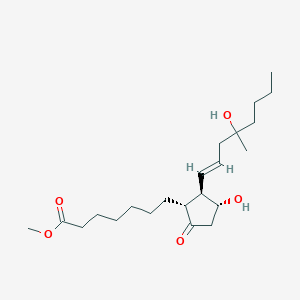| 1 |
ClinicalTrials.gov (NCT04533841) Propranolol and Misoprostol Versus Misoprostol Alone for Induction of Labor in Primigravidas
|
| 2 |
Propranolol FDA Label
|
| 3 |
URL: http://www.guidetopharmacology.org Nucleic Acids Res. 2015 Oct 12. pii: gkv1037. The IUPHAR/BPS Guide to PHARMACOLOGY in 2016: towards curated quantitative interactions between 1300 protein targets and 6000 ligands. (Ligand id: 7596).
|
| 4 |
URL: http://www.guidetopharmacology.org Nucleic Acids Res. 2015 Oct 12. pii: gkv1037. The IUPHAR/BPS Guide to PHARMACOLOGY in 2016: towards curated quantitative interactions between 1300 protein targets and 6000 ligands. (Ligand id: 1936).
|
| 5 |
Misoprostol FDA Label
|
| 6 |
beta2-adrenergic antagonists suppress pancreatic cancer cell invasion by inhibiting CREB, NFB and AP-1. Cancer Biol Ther. 2010 Jul 1;10(1):19-29.
|
| 7 |
Beta-blockers in the treatment of hypertension: are there clinically relevant differences Postgrad Med. 2009 May;121(3):90-8.
|
| 8 |
Tarascon Pocket Pharmacopoeia 2018 Classic Shirt-Pocket Edition.
|
| 9 |
Influx Transport of Cationic Drug at the Blood-Retinal Barrier: Impact on the Retinal Delivery of Neuroprotectants. Biol Pharm Bull. 2017;40(8):1139-1145.
|
| 10 |
Cytochrome P450 isozymes involved in propranolol metabolism in human liver microsomes. The role of CYP2D6 as ring-hydroxylase and CYP1A2 as N-desisopropylase. Drug Metab Dispos. 1994 Nov-Dec;22(6):909-15.
|
| 11 |
Synthetic and natural compounds that interact with human cytochrome P450 1A2 and implications in drug development. Curr Med Chem. 2009;16(31):4066-218.
|
| 12 |
Structure-activity relationship for human cytochrome P450 substrates and inhibitors. Drug Metab Rev. 2002 Feb-May;34(1-2):69-82.
|
| 13 |
The influence of diltiazem versus cimetidine on propranolol metabolism. J Clin Pharmacol. 1992 Dec;32(12):1099-104.
|
| 14 |
Clinical relevance of genetic polymorphisms in the human CYP2C subfamily. Br J Clin Pharmacol. 2001 Oct;52(4):349-55.
|
| 15 |
Human FMO2-based microbial whole-cell catalysts for drug metabolite synthesis. Microb Cell Fact. 2015 Jun 12;14:82.
|
| 16 |
acillus megaterium SF185 spores exert protective effects against oxidative stress in vivo and in vitro. Sci Rep. 2019 Aug 19;9(1):12082.
|
| 17 |
Comparative study of the oxidation of propranolol enantiomers in hepatic and small intestinal microsomes from cynomolgus and marmoset monkeys. Chem Biol Interact. 2010 Jan 5;183(1):67-78. doi: 10.1016/j.cbi.2009.10.007.
|
| 18 |
Rapid induction of P-glycoprotein expression by high permeability compounds in colonic cells in vitro: a possible source of transporter mediated drug interactions?. Biochem Pharmacol. 2004 Aug 15;68(4):783-90. doi: 10.1016/j.bcp.2004.05.006.
|
| 19 |
Comparison of HERG channel blocking effects of various beta-blockers-- implication for clinical strategy. Br J Pharmacol. 2006 Mar;147(6):642-52. doi: 10.1038/sj.bjp.0706508.
|
| 20 |
Additional gene variants reduce effectiveness of beta-blockers in the LQT1 form of long QT syndrome. J Cardiovasc Electrophysiol. 2004 Feb;15(2):190-9. doi: 10.1046/j.1540-8167.2004.03212.x.
|
| 21 |
Propranolol inhibits proliferation and induces apoptosis of hemangioma-derived endothelial cells via Akt pathway by down-regulating Ang-2 expression. Chem Biol Interact. 2020 Jan 25;316:108925. doi: 10.1016/j.cbi.2019.108925. Epub 2019 Dec 12.
|
| 22 |
Development of a common carp (Cyprinus carpio) pregnane X receptor (cPXR) transactivation reporter assay and its activation by azole fungicides and pharmaceutical chemicals. Toxicol In Vitro. 2017 Jun;41:114-122. doi: 10.1016/j.tiv.2017.02.023. Epub 2017 Mar 1.
|
| 23 |
Intrapatient comparison of treatment with chlorthalidone, spironolactone and propranolol in normoreninemic essential hypertension. Am J Cardiol. 1975 Oct 31;36(5):716-21. doi: 10.1016/0002-9149(75)90174-5.
|
| 24 |
Labetalol (AH5158), a competitive alpha- and beta-receptor blocking drug, in the management of hypertension. Aust N Z J Med. 1976 Aug;6(3 Suppl):83-8. doi: 10.1111/j.1445-5994.1976.tb03341.x.
|
| 25 |
Beta-adrenergic contribution to glucagon-induced glucose production and insulin secretion in uremia. Am J Physiol. 1986 Sep;251(3 Pt 1):E322-7. doi: 10.1152/ajpendo.1986.251.3.E322.
|
| 26 |
Expression of inwardly rectifying potassium channels (GIRKs) and beta-adrenergic regulation of breast cancer cell lines. BMC Cancer. 2004 Dec 16;4:93. doi: 10.1186/1471-2407-4-93.
|
| 27 |
Adrenergic modulation of cardiac development in the rat: effects of prenatal exposure to propranolol via continuous maternal infusion. J Dev Physiol. 1990 May;13(5):243-9.
|
| 28 |
Reciprocal in vivo regulation of myocardial G protein-coupled receptor kinase expression by beta-adrenergic receptor stimulation and blockade. Circulation. 1998 Oct 27;98(17):1783-9. doi: 10.1161/01.cir.98.17.1783.
|
| 29 |
Propranolol inhibits proliferation and invasion of hemangioma-derived endothelial cells by suppressing the DLL4/Notch1/Akt pathway. Chem Biol Interact. 2018 Oct 1;294:28-33. doi: 10.1016/j.cbi.2018.08.018. Epub 2018 Aug 18.
|
| 30 |
Palmitate increases the susceptibility of cells to drug-induced toxicity: an in vitro method to identify drugs with potential contraindications in patients with metabolic disease. Toxicol Sci. 2012 Oct;129(2):346-62. doi: 10.1093/toxsci/kfs208. Epub 2012 Jun 14.
|
| 31 |
Inhibition of pancreatic cancer cell proliferation by propranolol occurs through apoptosis induction: the study of beta-adrenoceptor antagonist's anticancer effect in pancreatic cancer cell. Pancreas. 2009 Jan;38(1):94-100. doi: 10.1097/MPA.0b013e318184f50c.
|
| 32 |
An effector domain mutant of Arf6 implicates phospholipase D in endosomal membrane recycling. Mol Biol Cell. 2006 Jan;17(1):327-35. doi: 10.1091/mbc.e05-06-0523. Epub 2005 Nov 9.
|
| 33 |
ADReCS-Target: target profiles for aiding drug safety research and application. Nucleic Acids Res. 2018 Jan 4;46(D1):D911-D917. doi: 10.1093/nar/gkx899.
|
| 34 |
Palmitoylation of the human prostacyclin receptor. Functional implications of palmitoylation and isoprenylation. J Biol Chem. 2003 Feb 28;278(9):6947-58.
|
| 35 |
Prostaglandin E2 regulates Th17 cell differentiation and function through cyclic AMP and EP2/EP4 receptor signaling. J Exp Med. 2009 Mar 16;206(3):535-48. doi: 10.1084/jem.20082293. Epub 2009 Mar 9.
|
|
|
|
|
|
|


